
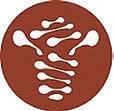
HEREFORDS Special Edition Sustainability l Productivity l Quality HEREFORDS AUSTRALIA Australia
TALBALBA is a family owned business at Millmerran run with passion, integrity and thorough knowledge of our breeding stock for generations.

We source the best genetics we can find within Australia, New Zealand and the USA using balanced sire selection criteria (both phenotype and data) from herds with similar breeding philosophies.
Fertility is the No. 1 profit driver in any beef herd. Heifers are expected to calve unassisted at 22-24 months to high calving ease, low-mod birth weight sires. Our cows calve in Spring with no excuses and no drift to Autumn for late calvers.
Our herd has been performance recorded since the 1970’s with Breedplan. We collect data honestly and carefully to maintain its integrity and submit TSU’s for genomically enhanced EBV’s. For the past 12 years we have been genetically dehorning using homozygous polled sires. We apply strict selection pressure to structure and feet and don’t hoof trim any animals.
We utilise sustainable farming practices and take pride in improvements to our soil, pasture, water quality and infrastructure. We have seen significant improvement in our pastures in recent years with advice from consultant Rob Young, following “Grazing Naturally” methodology.
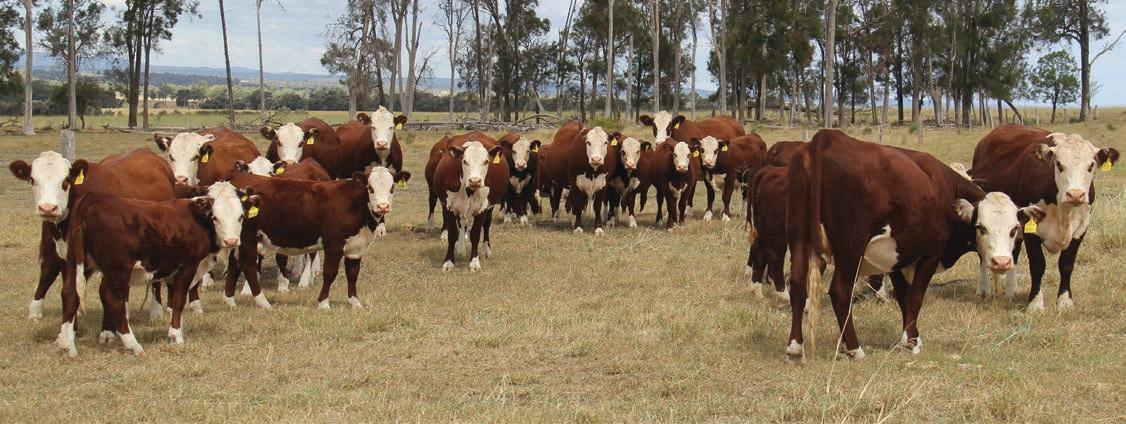
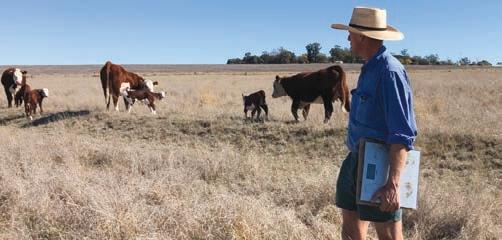

TO HEAR MORE ABOUT OUR STORY PLEASE CONTACT US, VISITORS ARE WELCOME ANYTIME
We enjoy showing people through our cattle and discussing our breeding program
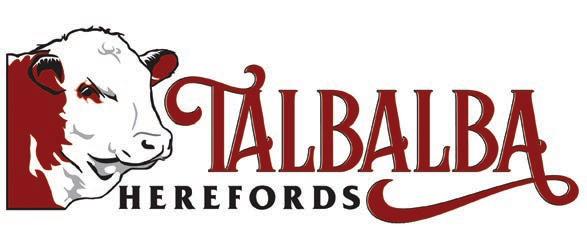 Calves are weighed at birth for solid data to enhance the accuracy of EBVs. This also enables accurate selection of bulls suitable for heifer joining.
Calves are weighed at birth for solid data to enhance the accuracy of EBVs. This also enables accurate selection of bulls suitable for heifer joining.
Steve Reid 0427 631 014
www.talbalba.com
BULLS FOR SALE
29th August 2024 @ 11.30am
Vaccinated Tick Fever, Vibrio, B.E.F., Pestigard, 5 in 1
Comprehensive Breedplan data available including Days to Calving & Dam’s Calving Interval FREE DELIVERY WITHIN 500KM OR BY PRIOR ARRANGEMENT
TALBALBA is NOT COMPLEX - we just do
Our females are run under commercial conditions on natural and improved pasture. Sale bulls are run on pasture and prepared for sale off oats with no grain supplementation.
Ph
talbalbastud@bigpond.com
65
Thursday
•
•
Our program at
the BASICS RIGHT
year-old heifers
Southern
pregnancy
in calf - March 2024.
Recent purchase - Days Landlord T064 (PP) excellent phenotype and all indexes in top 1% of the breed.
Two
with calves at foot by Tobruk
Cross,
tested
CONTACTS
Editor
Kim Woods
Outcross Media
Email: kim@outcrossmedia.com.au
Art direction and design
Michelle Hoffman
Email: mh_design1@outlook.com
Advertising
Annette Weatherstone
Email: annette.herefords@gmail.com
Publisher
Herefords Australia
ABN 86 121 714 332
Email: info@herefordsaustralia.com.au
www.herefordsaustralia.com.au
P: 02 6772 1399

Contents
Heavyweight grain fed carcases for premium markets
Market flexibility for grass and grain
Taking advantage of Hereford’s carcase traits
Herefords driving weight for age
Hitting production and productivity targets
Flatbacks hit market specifications
Jarrah Herefords thriving and multiplying in Northern Australia
Real time livestock weight monitoring unlocks value for producers
Lift docility, weight gain, fertility and compliance in one cross
Carcase traits of fat cover, yield and eating quality from Hereford/Brahman cross cattle are proving to be money in the pocket for a central Queensland family targeting an organic beef brand. Read more page 14. Image courtesy Dunne family

Herefords - at the forefront of beef industry innovation

BREEDERS of Hereford cattle know there is no better breed to finish on grass or grain delivering an efficient production system and producing top-quality beef.
Hereford cattle compliment nearly every other breed in a crossbreeding scenario. This is particularly the case in northern Australia where crosses deliver rapid rates of productivity through hybrid vigour and make faster progress on the key profit drivers in a commercial business.
Unlocking insights that drive profitability
Rising beef industry advocate for northern Australia
Flying high in the Australian beef industry
Beef connoisseurs vote for Hereford
The main profit drivers in a commercial beef business include fertility, longevity, growth, weight for age, feed efficiency, low cost of production, and high-quality carcase outcomes. These are all things Hereford and Hereford cross cattle deliver.
We welcome collaboration with all breeders of beef cattle and the supply chain as we need to work together to deliver productivity driven sustainability solutions for the Australian beef industry.
Michael Crowley Chief Executive Officer Herefords Australia
l HEREFORDS Australia 3
Articles appearing in the Herefords Australia magazine do not necessarily represent the policies, opinions or views of Hereford Australia.
10 12 14 16 17 18 19 20 21 22
4 6 8
Using Herefords to produce heavyweight grain fed carcases for premium markets
HEREFORD’S early maturity, weight gain and finishing ability on grain is resulting in a profitable return on investment for a family-owned breeding and lot feeding enterprise in southern Queensland.
The Bowhay family specialises in finishing steers and cull heifers for 100 days on grain to 400kg carcase weight with low ossification scores, and marble scores of 1 to 2 before the age of two years.
“The carcase specs are 320-400kg – that is an easy target for us to hit when turning the cattle off by two years and the Herefords do that comfortably,” Mark Bowhay said.
George and Robyn Bowhay, their son Mark and his wife Rina, and his brother Stephen, operate Buckinbah, a vertically integrated cropping and beef enterprise across 16,194ha at St George, value adding grain through an accredited 500 head on-farm feedlot to turn off heavyweight steers to Kilcoy Global Foods.
The September/October calving herd of 850 Hereford cows is run on black soil Mitchell grass and red Mulga country in a 475mm rainfall zone.
An irrigated cropping program produces wheat and fodder for the feedlot while the cow herd grazes Mitchell and Buffel grass pastures. Calves are bunk trained at weaning in the feedlot and then finished to feedlot entry weight on grazing oats.
The family sources bulls from Talbalba Herefords and uses artificial insemination every few years in selected heifers for rapid genetic gain.
They cull hard on fertility and were previously part of the Meat and Livestock Australia’s CashCow project. The project investigated the causes of poor reproductive performance in northern Australian beef herds, including environment, nutrition, management and infectious disease.
“Usually, we only join for two months, and we are always striving for fertility. Our heifers don’t get any special consideration and we fertility test our bulls every year,” Mark said.
“The CashCow project gave us a lot of good feedback on nutrition – we were happy with our fertility rates with the cows up around an average of 90 per cent calving rates over the life of CashCow.
“We strive to be up around 97 per cent calving rate and maintain that. Nutrition plays a part in fertility with a lot of Australian soils being phosphorus deficient, but a big part is management.”
The “deal breaker” traits in bulls are 600-day weight estimated breeding value, scrotal circumference over 40cm and 100 per cent eye pigment in both eyes. Maternal traits including milk and carcase indicators such as eye muscle area and intramuscular fat are also considered.
The family classes their own heifers and grows them out for joining as two-year-olds.
“We are not turning out weaners but heavyweight feeder steers to be finished by the age of two years,” Mark said.
“Kilcoy is our preferred destination, and the top of the grid is 400kg carcase weight. We need bone, length, depth and width in those calves. So, we are looking for large framed, fertile cows and big, fleshy bulls.
“Those steers have to be gone by the age of two – we don’t hang on to them until they are two-and-a-half or three-years-old.
“Our cast-for-age cows are also finished in the feedlot to over 800kg liveweight, so we lose there if we join them too young as heifers. It is a trade-off and one we are happy running with.”
The joining percentage has slowly declined from four bulls to 100 cows and is now at 3 per cent.
“CashCow pushed for a lower percentage and once again it is a trade off – the bulls are capable of doing better and I would be comfortable at 2 per cent, but in the commercial herd setting we don’t see them every day.
“We join the heifers for eight weeks and the cows 12 weeks in November to January, aiming for conception in those first two cycles but in saying that the weather can be quite hot (affecting fertility).
“We like the cows to calve a bit lighter in condition and then be on a rising plane of nutrition.”
Calves are weaned into the feedlot according to seasonal conditions rather than weight and bunk trained on a grain and fodder ration.
“The feedlot gives us the flexibility to wean calves earlier if we have to. It was built as a risk management tool for consistently turning off heavyweight steers by the age of two for premium markets in our variable climate,” Mark said.
“Our ration is a simple, traditional one of home-grown wheat and hay with the additives. Wheat is what cattle will perform on but it is higher risk, so we carefully manage the feeding in those first three weeks.
“We are aiming for the 400kg carcase, even in our cull heifers, so have two entry points a year – the first entry is for all steers and the second for cull heifers and tail end steers.
“We try not to feed over summer as we don’t get the average daily gain due to the heat. So, we calve over summer during our greatest grass growth, put the calves in the feedlot at the end of that pasture growth, and they are gone by the time they are two.”
Being one mark and vendor bred, the steers are well socialised and educated to the feedlot beforehand.
An average daily gain target during the 100-day grain fed program is 2.5kg.
“We find the Herefords are feed efficient and the quiet temperament never goes astray. The heifers have the
4 HEREFORDS Australia l
frame size to carry a 100-day feeding and can perform without a growth promotant,” Mark said.
Mark said the full Meat Standards Australia chiller feedback is evaluated and used to fine tune the breeding or feeding programs.
“Kilcoy also gives us their internal benchmarking feedback for the cattle killed in the same fortnight.
"It is handy to compare all the 100-day grain fed cattle subject to the same humidity and heat events and processed at the same time. They may have been under different feed rations and management, but they had to put up with the same weather conditions,” he said.
“Our average MSA Index is in the high 50s and 70 per cent of
the bodies a marble score one. The ossification of our cattle usually shows up well as they are younger at heavier weights compared to the other breeds with a MSA score of 100 to 150.
“The Herefords early maturity and finishing ability at a younger age is an absolute advantage and that shows up in our benchmarking.”

Beef up your herd’s performance with



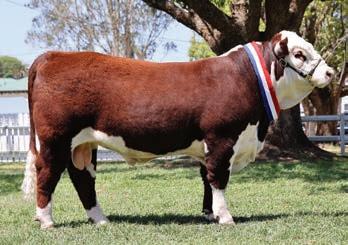
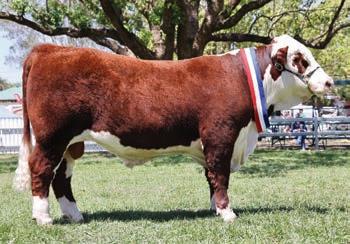
l HEREFORDS Australia 5 “Forest Lodge”, 161 Hickeys Road, Wongwibinda NSW Richard Ogilvie - M: 0488 758 490 l E: richardteangie@gmail.com Michael Ogilvie - M: 0408 154 472 l E: michaelteangie@gmail.com Te-Angie
Genetics
RGOT008
RGOT004
RGOT006
Stephen, George, Mark and Matthew Bowhay in their feedlot on Buckinbah at St George. Image: Steve Reid
Herefords provide market flexibility for Willinga in grass and grain programs
SUPERIOR weight gain and carcase compliance in Hereford cattle are giving one Queensland based pastoral company market flexibility in grass finishing, lot feeding and custom feeding for supermarket and specialty beef brands.
Willinga Pastoral Co comprises a portfolio of 11 western downs properties totalling 70,420 ha in the Wandoan, Taroom, Condamine and Kandanga regions and carrying more than 15,000 cattle in breeder, backgrounding and fattening operations employing 28 full-time staff.
The aggregation has a breeding herd of 7000-8000 females, of which half are straightbred Herefords and the balance are Santa Gertrudis joined to Hereford bulls. The goal is to build to 10,000 breeders.
The 28,444 ha hub property, Juandah Plains at Wandoan, runs 2000-2500 Hereford breeders joined to Hereford and Santa Gertrudis bulls. Steers and first cross heifers are fattened at the backgrounding properties of Karalee Plains and Marama.
When it comes to the strengths of the Hereford breed in the northern climate, General Manager Andrew Turvey rates fertility highly, along with finishing ability off grass, carcase quality and Meat Standards Australia (MSA) compliance.
“Herefords perform well in our country with weight gain and when we are taking them all the way
through, MSA grading is important,” Mr Turvey said.
“An early maturing, highly productive, highly fertile herd and having the turnover of animals finishing a lot younger at 14 months of age at 600kg helps us towards that end goal.”
Mr Turvey ranks fertility as a key profit driver and is impressed with the early maturing females in the Juandah Plains herd.
“We had a tough year with not much rain April to December only receiving 40 per cent of our annual rainfall and yet we still achieved 83 per cent pregnancy tested in calf heifers weighing 280kg in the first two cycles and grazed on dry Buffel grass supplemented with cotton seed.”
Bulls are joined at 2.5 per cent while the heifers are joined at 14 months of age over 10 weeks to calve at two years. After pregnancy testing, any empty females are pasture finished for the supermarket trade. Elite heifers will be identified for a planned artificial insemination program this year to breed herd bulls for joining to commercial Santa Gertrudis cows.
Bull longevity is important in lowering the cost per calf, and the bulls must be structurally sound to walk long distances and withstand the climatic conditions.
“I’m looking for an early maturing animal with the fertility traits, especially days to calving, milk and
early growth, along with IMF (intramuscular fat), eye pigment, hooded eyes and a slick coat,” Mr Turvey said.
He uses the livestock analysis and insight software, Black Box Co, to evaluate herd efficiencies in fertility and performance to help with the selection of genetics.
“We are collecting data from conception to carcase. Fertility, growth, feedlot performance and chiller data will assist us with identifying superior sire lines. Earlier maturing females and bull longevity are a major driver in our business.
“Black Box Co are evaluating our feedlot and carcase data to give us both the average daily gains of the cattle in the feedlot plus the shrinkage and yield comparison.”
The in-paddock weighing system, Optiweigh, is used on all the properties to collect average daily gain data in real time.
“This is an important part of our backgrounding operation so we can keep an eye on how they are progressing. We also use it for our heifers when reaching critical mating weight.”
Willinga Pastoral Co has undergone a rapid expansion of cattle numbers and capital infrastructure in the last two years on all properties, including fencing, water and pastures.
The aggregation has a breeding herd of 7000-8000 females, of which half are straightbred Herefords and the balance are Santa Gertrudis joined to Hereford bulls.
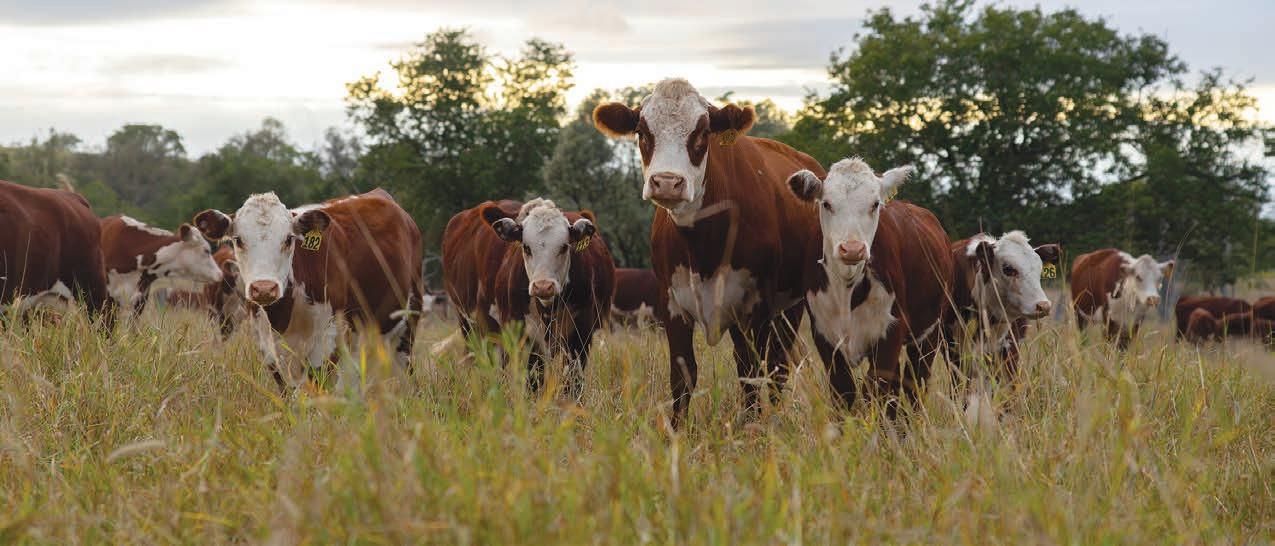
6 HEREFORDS Australia l

Rainfall averages 650mm at Wandoan and the country comprises Brigalow softwood scrub to box and open forest with pastures of Gatton panic, Bambatsi, Rhodes, Premier Digit, Bisset Creeping Blue and Buffel grass along with medics, stylos, wynn cassia and progardes desmantus.
“We are still building the herd as we improve the country,” Mr Turvey said.
“This summer we have sown Rhodes grass, Gatton panic, premier digit, bambatsi and virgatus across 6073ha with good rain across all properties resulting in good establishment. We also have some cropping country growing winter fodder for finishing cattle.
“The improved pastures, new fencing and increase in water infrastructure has enabled us to double our carrying capacity.”
Spring drop calves are yard weaned in mobs of 500 for a week in May/June and then moved to the company’s backgrounding properties for finishing on improved pastures and fodder crops.
Willinga Pastoral Co custom feeds Hereford steers and surplus heifers from a feedlot entry of 360-420kg liveweight across 70-80 days at Wallumba feedlot, Condamine, to deliver a carcase weight of 300-330kg.
Mr Turvey said the average daily gains in the custom fed operation over 70 to 80 days were consistently over 2kg for hormone growth promotant free Hereford steers and heifers.


Yearling steers are also taken to 480-500kg liveweight for export feeder entry weights or finished on pasture to 650kg liveweight for a grass-fed product for major supermarkets.
Most recently, widespread rain and abundant feed has resulted in Willinga purchasing lines of Hereford steers weighing 280-300kg liveweight from the January 2024 southern weaner sales.
“Those 550 steers are being finished on our fattening property, Naturi Aggregation, located on the Condamine River for grass or grain fed options. We like the Herefords as they offer consistency and can fit into any market,” Mr Turvey said.
“We are really happy with the quality of the steers and were well ahead even with the transport costs.”
Willinga Pastoral Co also has a goal to produce a Certified Carbon Neutral product which aims to reduce the carbon footprint through best practice farming.
Mr Turvey said the pastoral company was lowering its carbon footprint through significant capital investment into its assets.
“Environmentally responsible grazing management with a focus on herd efficiency, maximising growth rates to deliver an efficient high-quality eating product are our passion.
“We are investing in emission reduction strategies including renewable energy across all of our properties.”
Solar panels and roof arrays are connected to inverters and 24 batteries, taking the hub property Juandah Plains off grid, and powering all bores, tanks and troughs. Around 700km of new fencing has been erected to optimise grazing and pasture growth.
Willinga is developing a range of carbon projects that will be a demonstration of what is possible in central Queensland conditions.
The combination of a highly efficient cattle herd, clarity and alignment with target markets, grazing management, pasture improvement and a focus on the bottom line are combining to deliver a sustainable business for Willinga Pastoral Co.




l HEREFORDS Australia 7
Bulls ready and available for your next cross breeding program “Rowden Farm”, 1106 Bell-Kaimkillenbun Road, KAIMKILLENBUN Wes Lowien 0418 989 285 l e: wlowien@gmail.com
Willinga Pastoral Co General Manager Andrew Turvey and Herefords Australia Chief Executive Officer Michael Crowley at Juandah Plains.
Northern crossbreeding program takes advantage of Hereford’s carcase traits
HEREFORD bulls have been selected to inject butt shape, fat cover and eating quality in a crossbreeding program using Droughtmaster and Charmaster cows in northern Queensland.
Mac and Gayle Shann run a breeding herd of 1000 females at Cantaur Park Droughtmasters, northeast of Clermont, and run comparative crossbreeding trials to produce tropically adaptable flatbacks with superior carcase traits.
The couple has a crossbreeding program using 300 cows joined to either Hereford or Charolais bulls, and 170 Charmaster (Charolais/ Droughtmaster) cows joined to Droughtmaster, Hereford or Shorthorn bulls.
Their 11,000ha property is set in a 650mm rainfall zone and comprises loamy river, sodic clay, and lighter Ironbark soil types.
Mac and Gayle invested in three Hereford bulls in 2022, including Tycolah and Mountain Valley bulls, to inject butt shape, fat cover and eating quality.
“We are running a trial to compare differences in meat quality – we do
enter quite a few carcase competitions for the chiller feedback,” Mr Shann said.
“We were looking for a bull carrying the right amount of meat and were open minded about the breed as there are really good cattle in every breed.
“I look through thousands of bulls every year and what really caught my eye were bulls that carried a huge amount of flesh.”
Mr Shann selected the Hereford bulls on weight for age, body length, conformation, muscle pattern and softness. He noticed a Tycolah bred bull in the 2022 Sire Shoot Out catalogue, drawing him to the stud’s website’s listing of Tycolah Terry R017, a homozygous polled bull with calving ease, and above average growth and muscle.
They were joined alongside Charolais bulls in paddocks of up to 1214ha.
“The bulls went out with the cows on September 1 and have handled the season well, especially the older bull literally trotting from cow to cow,” Mr Shann said.
“The Hereford cross calves began dropping in late June (2023) with no calving issues and are looking very good at the moment (February) with weights rising 250kg and they will be weaned in April/May at 300kg plus.
“The steers will be finished as feeders or the top end may go into a show team on grain for us to


8 HEREFORDS Australia l
Hereford/Droughtmaster
heifers aged five to eight months and growing out on marginal forest country for joining in September.
All Images: Shann family

test them out. The top end heifers will be kept for the crossbreeding program and the rest will be sold as feeder heifers.”
Mr Shann said the injection of Hereford would increase fat coverage, the MSA Index, eye muscle area, red meat yield, tenderness and flavour in carcases for taste test competitions the family regularly enters.
“We are looking to get a more tender animal with softness and finishing ability in the Hereford cross to lift that MSA Index.
“The Hereford cross calves already look like they have nice fat cover.”

Cantaur Park has 270 steers on feed to choose 10 pens for the commercial cattle classes and will exhibit one bull in the led classes at Beef Australia 2024.
“If we can show the industry our cattle finish well and are performing on the hook, hopefully we can influence those producers who are carrying bullocks through to 2632 months of age.
“By using a British bred bull, they can achieve an earlier turn off at heavier weights.”
The Shann’s are planning to run an open final at the 2024 Mt Coolon Campdraft in June using all red baldy steers to promote the first cross Hereford.
MARSHALL MULTISPREAD









l HEREFORDS Australia 9 * Dynamically Balanced Rolls * Folding Auger * Chill Cast Rolls * PTO or Electric *16” Roller Diameter *12”, 24”, 36” & 48” Roller Widths Australian Distributor EASTERN SPREADERS PTY LTD 9508 Murray Valley Highway, Kerang, Vic. 3579 Ph: 03 5450 3077 Mobile: 0409 691 226 or 0429 480 337 easternspreaders.com.au The ideal spreader for all types of granular fertilizers, lime, gypsum and manures. 2.5 to16 Tonne Models . i4M System to control applications, Weighing Systems, 3 Metre Track available
Quick & effective mixing. Complete and rapid emptying. What you put in your mix gets to your herd, consistently. Single or dual auger models available. Large curved knives. FEEDMIXERS ROLLER MILLS
to 40 cubic metre
10
models
Hauff family breeding fertile, heavy weight for age, highly sought after cattle
HEREFORD cattle with muscle, temperament, and the ability to press down the scales are the main profit drivers for one central outback Queensland family.
Third generation commercial producer Bevan Hauff and his brother Tony trade as C A Hauff & Son, and run 1500 breeders or 4000 head across Colart Station and The Springs, totalling 28,340ha.
Bevan and his wife Julie live at Colart whilst Tony and his wife Diane live at The Springs.
The Blackall based aggregation is one of the largest purebred Hereford herds in Queensland and predominantly targets the eastern states feeder market.
“Weight for age is where they make money for us. We can hang weight on them and they can handle it. Herefords have fertility, weight gain, temperament and market flexibility –those are the four attributes that stick by us,” Bevan said.
“We are not pin holed into one specific market – we can meet a trade market, feeder market or carry them through to bullocks.
“We can get our cattle easily to feeder weight off our country. Our weaner steers average 280-320kg, coming straight off their mothers and into a fresh paddock.”
The cattle are run in 450-550mm rainfall zone on black to red loam soils with pastures consisting of Mitchell and Buffel grass alongside seasonal herbages.
If the season permits, this paddock would usually be blade ploughed with improved pastures providing a real boost to carrying capacity and weight gain.
The family has undertaken a pasture rejuvenation program sowing legumes, such as butterfly pea and desmanthus along with other grasses including Gatton and bambatsi panic, to provide a boost to soil health and structure and variety for their cattle.
Being a family run operation, Bevan and Tony place emphasis on the temperament of their herd.
“We are heavily family orientated and have involved our children when working cattle throughout their upbringing, so the temperament of our cattle was and still remains very important.”
The Hauff brothers purchase 10 to 15 bulls a year, predominantly from Queensland studs Talbalba, Devon Court and Lambert, and select for a balanced set of EBVs.
“One of the strengths we look for in a bull is ensuring they are structurally correct and can walk the distances. We buy bulls with below
average birthweight, moderate mature cow weight and above average 400 and 600-day weight,” Bevan said.
“We aim to produce a structurally correct, moderate framed, efficient cow which milks well.
“The bulls we are selecting now are certainly different from 20 years ago. Now we are selecting a more moderately framed, heavily muscled bull with good calving ease.”
The breeders are grazed in average paddocks sizes of 1021-1214ha with heifers joined at 14 months of age for either an autumn or spring calving.
“We cannot go past the fertility of our Hereford cows with up to 90 per cent calving in our herd.”
Heifers are pregnancy tested with conception rates averaging 85 to 95 per cent. Cull heifers are finished for the supermarket trade or sold on AuctionsPlus to NSW restockers.
The weaners come off at around 10 months of age and are educated to horses, bikes and dogs before being grazed on forage pastures in paddocks up to 3239ha.
“We are aiming to run 2000 breeders but have reduced that to a sustainable number of 1500-1800 head, allowing us to carry more feeder steers,” Bevan said.

10 HEREFORDS Australia l
This group of feeder steers weighing 400-460kg live weight are being fattened on the Hauff family properties. All images: Diane Hauff.

“Our feeders are well sought after not only by feedlots in the Darling Downs region, but also sold across the country to others including Princess Royal feedlot, Burra, South Australia.”
The steers are grown to an average of 460kg liveweight for short fed supermarket programs at feedlots and any overweight cattle are sold through prime markets at Blackall saleyards. Backgrounder Hereford steers are also purchased when the season permits from another commercial producer at Longreach and carried through to feeder weights alongside their own cattle to value add.
The family contributes steers annually to Queensland’s only multi-vendor single bloodline store sale for Hereford genetics at the Lambert Stud infused feeder and weaner sale at Blackall saleyards in September. They won champion pen of heifers in 2023 with females weighing 444kg. Their 509kg feeder steers were runners-up in the 381-520kg class steer competition.
“With the introduction of MSA grading, many more producers have opened their eyes to Herefords in an attempt to seek more consistent weight gain over other breeds,” Bevan said.
“As commercial producers we need to be in contact with our stud breeders to let them know our requirements. Technology allows us to keep up to date with what bulls are on the ground and follow their genetic data set, so it is becoming easier to find where the good bulls are.”
Bevan is pleased with how the breeding goals for low birthweight, high calving ease, weight for age, muscle

TOP PIC: A group of maiden Hereford heifers, pregnancy tested in calf and running on pulled Gidyea country.
ABOVE: A large framed Hereford cow with a low birthweight calf.
BOTTOM LEFT: The Hauff family purchases around 15 bulls a year, predominantly Queensland bred from Talbalba, Devon Court and Lambert studs, and select for a balanced set of EBVs. This is a Devon Court sire purchased in 2022.
BOTTOM RIGHT: A Poll Hereford steer weaned in September 2023.
and eye pigment over the years are shaping the cow herd today.
“It gives us a great deal of satisfaction to see it,” he said.

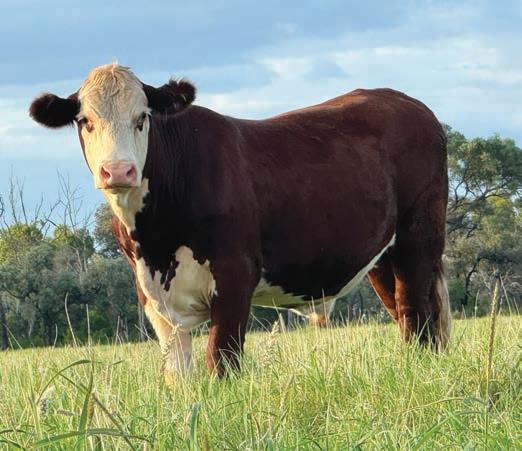
l HEREFORDS Australia 11
Hitting the production and productivity targets with Hereford infused genetics
SUPERIOR Hereford animals identified through performance recording and genomics are being used to build a unique stabilised herd of tropically adapted flatbacks by a central Queensland family.
The tick resistance and heat tolerance from the Bos indicus combines with the temperament, grass conversion and carcase quality of the Hereford to give a productive herd with market flexibility and Meat Standards Australia compliance for the Marks family, of Winvic Pastoral, Clermont.
Darren and Alice Marks, and their daughter Olivia, operate four properties, Winvic Pastoral, comprising 10,074ha of open black soil downs to red gidgee and brigalow melon hole country and sitting in a 560-1000mm rainfall zone.
The family joins 1000 commercial breeders and 160 seedstock females producing performance recorded progeny through the Tropical Composite Group BREEDPLAN, which evaluates and compares sires and dams for docility, fertility, growth and carcase traits.
Elite females identified using genomic breeding values, estimated breeding values (EBVs) and phenotype are used as donors in IVF programs.
The cattle graze pastures of Buffel grass, native blue grass over sown with legumes and bambatsi, forage crops and 885ha of luecaena.
Cow body condition determines weaning with the calves yard weaned in June/July for 7-10 days on hay, and educated to horses and dogs.
The available feed resources are monitored and evaluated to determine the length of time sale cattle are finished. The system has transitioned from weaner and feeder production back to bullock production with steers turned off at 650kg liveweight and heifers to 500kg plus.
The heifers are supplied to the grass fed, free range, antibiotic and hormone free programs including Teys Grasslands and JBS Right to Roam.
The crossbred sale cattle range from 7/8ths Hereford content to almost pure Bos indicus.
Winvic Pastoral is using Black Box Co to link lifetime data to carcase data, identifying high and low performing animals by average daily gain and carcase performance to inform management and genetic decisions.
“We are just starting to gain insights of what the performance is like – the early data is telling us about a variance with marbling. Lifting marbling scores and eating quality is a focus of our breeding program,” Mrs Marks said.
“We scan our heifers and bulls as yearlings to select for high marbling and correlate that with weight and eye muscle area. Those traits can be antagonistic so it’s about finding that middle ground within the phenotype we like.
“The Bos Indicus and the Hereford are a perfect match with the environmental adaptability of the Bos Indicus and the temperament, grass conversion and performance from the Hereford.
“For me, docility is the number one advantages of the breed – they are a pleasure to work with. The objective measurement provided by Hereford stud breeders helps to inform purchase selection, especially fertility, days to calving, and carcase traits.”
Winvic Pastoral uses Australian and US Hereford sires via natural joinings and artificial insemination.
Young Hereford infused bulls are from a tight joining window and performance measured since birth including yearling scanning for intramuscular fat and eye muscle area.
“It is a crossbreeding system that has been delivering improved productivity and efficiency within our herd for the past 12 years.”
A draft of 90 Winvic commercial Hereford infused heifers are part of a research project evaluating herd/ flock measurement technologies and culling decisions of breeding stock.
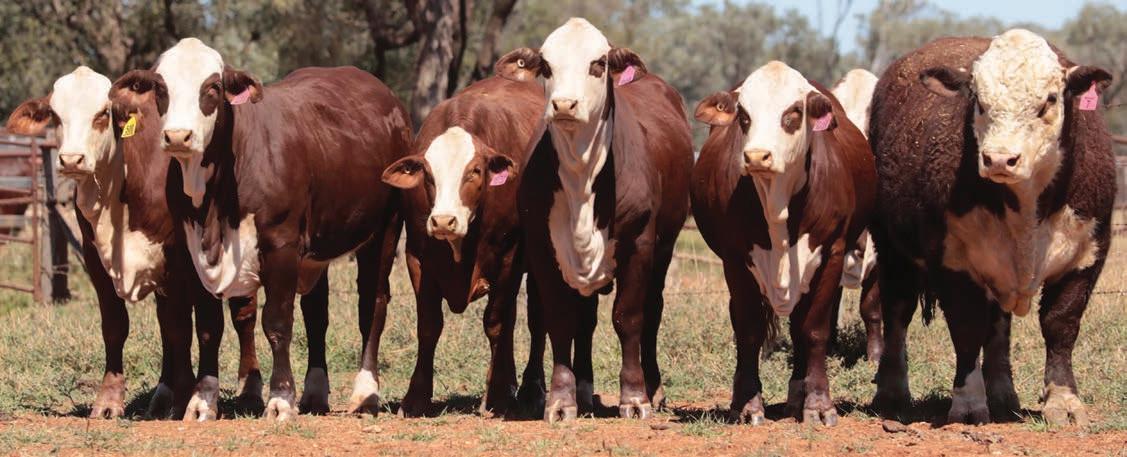
12 HEREFORDS Australia l
A homozygous polled Hereford bull with Braford females at Winvic Pastoral, Clermont. Image: Georgie Connor

The 18-month Decide and Thrive project is being delivered by the University of New England, Central Queensland University and CSIRO to help graziers develop innovative and regionally relevant livestock ranking strategies to secure farm businesses into, during and out of drought.
Two cohorts of Winvic heifers have participated in the Queensland Alliance for Agriculture and Food Innovation’s Northern Genomics Project to generate genomic breeding values with one of them also involved in the Decide and Thrive project.
“The yearling mated females are fitted with GPS trackers, have calved and been rejoined to Hereford cross bulls. An Optiweigh in-paddock weighing system is being used in the paddock to collect real time data on average daily gain with the aim of identifying which females are the most productive as far as adaptation goes. The GPS collars monitor where they are utilising the grass, grazing patterns and their reproductive performance,” Mrs Marks said.
“This will give us insights into heifer performance and the most productive females within that cohort.”
The Great Northerner



l HEREFORDS Australia 13
A Braford donor dam and her calves on Winvic Pastoral - two of the calves will be on display at Beef Australia 2024. Image: Olivia Marks
Hereford infused flatbacks hit the specifications in tropical organic system
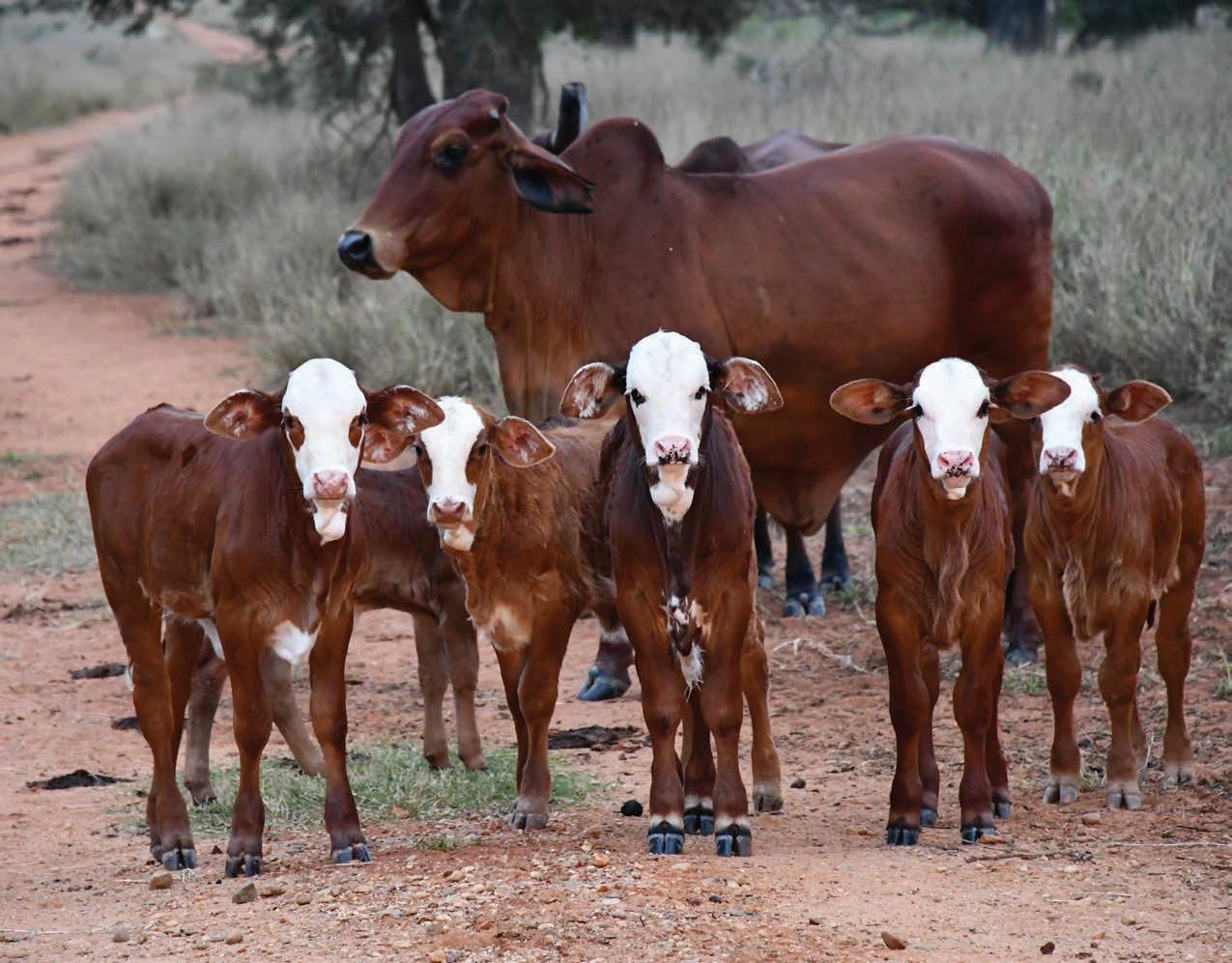
CARCASE traits of fat cover, yield and eating quality from Hereford/ Brahman cross cattle are proving to be money in the pocket for a central Queensland family targeting an organic beef brand.
Bill and Louise Dunne operate an aggregation of four certified organic properties, with the 4858ha home breeder block “Tarcoola”, 70km north of Dingo on the Mackenzie River.
The couple and their children Laura, Lawson and Fraser, fifth generation graziers, run 1200 red Brahman breeders joined to Hereford and Brangus bulls to produce flatback steers and surplus heifers for a certified organic beef brand.
Bill and Louise have used Hereford genetics in their crossbreeding
program for 24 years and displayed Hereford/Brahman steers at the Herefords Australia site at the 2018 Beef Australia.
“We have been experimenting with breeds to find a product the consumer wanted, and it was very clear they desired a flatback animal that made for a quality eating experience,” Mrs Dunne said.
They began sourcing Hereford bulls from Jarrah Genetics, Banana, to increase fertility, inject early maturity, lift carcase quality and meet MSA specifications.
“We find we can turn off the Hereford cross progeny six months earlier than what we used to when trading Brahmans – it has made a big difference and the proof is shown in
the data as we weigh the cattle on the fattening block,” Mrs Dunne said.
“Over the last 10 years we have focused on the Hereford as our main breed over the cows and in the last two years every paddock bar one is all Hereford bulls.
“As we source them locally, we know the paddock reared bulls are acclimatised so when they unload at home, they are ready to work.
“We look for a well-muscled bull with docility – we are pedantic about temperament. The milking and mothering ability is key along with their ability to work and thrive in our tropical environment.”
Mr Dunne prefers the homozygous polled bulls with 100 per cent eye pigment, and he is impressed with the
14 HEREFORDS Australia l
A red Brahman female and Hereford cross calves at “Tarcoola”, Dingo. Images: Dunne family
longevity of the breed with bulls being turned over at 10 years of age.
He said the F1 Hereford heifers are retained and joined to a Brangus bull for a terminal F2 product.
“The cattle are finished on 7km of Mackenzie River frontage near Rockhampton and 100 per cent of the time the Hereford cross is superior in their weight for age by a considerable amount compared to the fullblood Brahman,” Mrs Dunne said.
“People frequently comment on our solid calves and forward condition weaners – we are the only graziers up that beef road with the Herefords so they are standout in a paddock full of Brahmans or Brangus. Overall, calving ease is good with the Hereford bulls. Most calves are red and white while we find the brindle calves are more in the second cross.”
The Hereford bulls are left in the herd all year round, therefore consistently producing weaners across the year for management and cash flow.
The family produces their own organically certified hay under centre pivots to supplement the weaners. The weaners also receive OrganicFlo, a stock feed supplement with 10 per cent protein, to maintain a rising plane of nutrition therefore sustaining critical mating weights.
The calves are treated with a 7-in-1 and after weaning they are grown out to 450kg liveweight on Buffel grass
and legume pastures fertilised with an organically certified vermiculture product. The top heifers are then removed as replacements and the balance of the weaners are finished on forage sorghum or Lablab to a minimum of 530kg for selling direct to Clayton’s Organic Beef or through local store sales.
The Dunne’s enterprise is certified with Australian Certified Organic and undergoes an audit every year.
“We had ticked all the boxes before we began the certification process as our policy was a clean, green product. We looked into the organic market and when we realised we could obtain a premium price of $2-$3/kg for our product, it was an easy choice,” Mrs Dunne said.
“The Clayton’s Organic Beef buyer was really taken with the Hereford cross so that’s great for us as producers to get that feedback. Clayton’s look after us very well and quite frequently pay a higher premium than any other organic buyer.
“The fact we can tick that organic box, adds value to our beef as there are many discerning consumers willing to pay a little more, ensuring they know exactly what they are putting into their mouths. We are proud of what we are doing as a family, providing the consumers everything they want in their beef choice.
“The Herefords have come out trumps and they won’t be going anywhere – they are very much a firm favourite of all of us,” Mrs Dunne said.


l HEREFORDS Australia 15 RUNNING 250 REGISTERED STUD FEMALES - BULLS FOR SALE - VISITORS ALWAYS WELCOME KERRY & MC GLASSER AND PATRICK & ALANA GLASSER YAGABURNE, GOONDIWINDI QLD 4390 P 07 4675 4178 M 0427 754 178 E YAGABURNE@BIGPOND.COM SIRE IN USESIRE IN USE – BREEDING QUALITY CATTLE FOR 69 YEARS – SOLD FOR $120,000 RUNNING 250 REGISTERED STUD FEMALES - BULLS FOR SALE - VISITORS ALWAYS WELCOME KERRY & MC GLASSER AND PATRICK & ALANA GLASSER YAGABURNE, GOONDIWINDI QLD 4390 P 07 4675 4178 M 0427 754 178 E YAGABURNE@BIGPOND.COM SIRE IN USE SIRE IN USE GRAND CHAMPION DUBBO YARRANDABBIE RICHARD R004 THE RANCH REMINGTON R028 – BREEDING QUALITY CATTLE FOR 69 YEARS – SOLD FOR $70,000 SOLD FOR $120,000 bulls for sale - VISITORS ALWAYS WELCOME YAGABURNE POLL HEREFORDS Strong Genetics, Trusted Quality < Est. 1954 > Celebrating 70 Years RUNNING 250 REGISTERED STUD FEMALES
Jarrah Herefords thriving and multiplying in Northern Australia
JARRAH Hereford genetics are allowing producers in the north to run an adapted Hereford, already acclimatised to the conditions.
Jarrah Herefords principals Sam and Sarah Becker, base their breeding program around functionality and compliance to ensure their cattle can handle the tougher conditions, and produce a calf each year with premium market options.
“Our breeding philosophy has never wavered from mobile cattle with fertility, superior carcase and doing ability, designed to complement the Bos indicus breeder,” Mr Becker said.
“These attributes as well as sleek coats for heat and tick resistance help the cattle thrive in harder conditions.”
Sam and Sarah run 700 stud females and with their family 1200 commercial breeders in a vertically integrated operation in central Queensland. Their business ranges from breeding to backgrounding and trading cattle.
“We have our own commercial herd where we use all our own genetics and see first-hand the benefits of these attributes in improving our bottom line,” Mr Becker said.
“We are also now selling a lot of bulls to organic producers in tick and fly country, where they use a Hereford over high percentage Bos indicus breeders to improve MSA compliance and grading in their chosen market. Feedback from clients is that the bulls perform
well and handle the conditions.
“The Jarrah Hereford infusion gives extreme carcase to maximise weight gains on top of the hybrid vigour. As a result, Hereford cross progeny hit the flatback market in one cross.”

In line with these breeding philosophies, the Becker Family utilise BREEDPLAN data to ensure consistency and performance of their product, as well as place a strong emphasis on building relationships with their clients.
“Backing our breeding philosophies with leading data allows our cattle to perform with consistency and predictability under a range of conditions. We see this as an essential ingredient in giving our clients confidence in what they are purchasing,” Mr Becker said.
“We welcome client feedback and experience, enabling us to provide the optimum genetic package for their business goals, whether that be grass or grain fed markets.”



HEREFORDS Australia l
ADVERTORIAL
MONDAY 2 SEPTEMBER 2024 Annual Bull Sale 40 CQ Acclimatised Hereford Bulls (100% PP, P or S) 40 Jarrah Red Bulls ‘the clean-coated flatbacks’ Hit the premium flatback markets Add desirable carcass characteristics Boost MSA market suitability Sam Becker 0417 576 667 jarrahcattle.com.au
Sam and Sarah Becker, Jarrah Genetics principals.
Real time livestock weight monitoring unlocks value for producers
OPTIWEIGH is a fully portable inpaddock weighing system that works in all environments, does not require animal training or the installation of additional infrastructure.
The winner of the Meat & Livestock Australia Producer Innovation Award at Beef Australia 2021, Optiweigh enables in-paddock weighing and monitoring of cattle.
Developed by northern NSW producer Bill Mitchell, the Optiweigh systems records the weights of cattle as they are drawn to the unit by a lick or salt block.
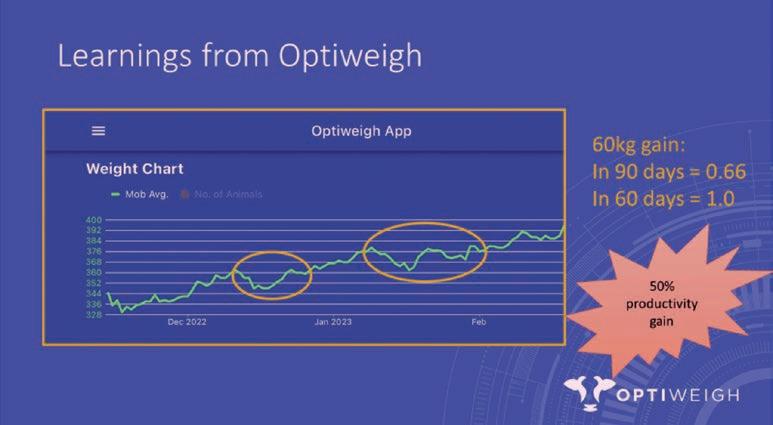
By collecting this data, the results can be reviewed daily enabling real time livestock weight monitoring unlocking value for the producer.
The system measures average daily gain of the mob and individual animal performance which can be used to predict market readiness of steers, joining weights of heifers, give early indications for animal health treatments
or any fluctuations in animal performance and pasture performance not easily assessed visually.
The portable Optiweigh can be towed behind a ute, side by side or quad bike with an easy setup and reduces the need to weigh cattle in the yards as regularly, reducing labor and animal stress.
The company has machines across the country, including remote areas across the north.









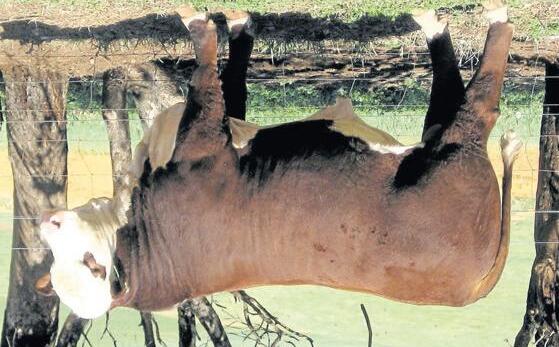









l CARCASE FOCUS On Property Auction TUESDAY 20TH www.auctionplus.com.au for videopresentations -Interfaced CARCASE FOCUS On Property Auction TUESDAY 20TH 96 POLLED BULLS 250 COMMERCIAL PTIC HEIFERS Featuring: • 58 Specialist Heifer Bulls • 100% Sire edVerifi • 73 Homozygous Poll Bulls On Property “Kiloran” Book Book via WAGGA WAGGA, NSW LOT 7 - Exceptional Carcase Fertility is Profit Contact Marc Greening P 0411 043 039 E marc@injemira.com.au W www.injemira.com.au PROUDLY SUPPLYING BULLS THROUGHOUT QLD Injemira sired calves - Willinga Pastoral Co - “Naturi” Condamine QLD
Lift docility, weight gain, fertility and MSA compliance in one cross
MOUNTAIN Valley Herefords is demonstrating the numerous benefits Hereford cattle have to offer northern beef production systems, with bulls selling into central and northern Queensland.
According to Mountain Valley stud principal, Ian Durkin, of Coolatai, NSW, their bulls sell into both purebred Hereford herds and crossbreeding operations.
“I’ve got a client who uses Hereford bulls over his Santa Gertrudis cows, and the crossbred calves are on average 30kg heavier at weaning,” Mr Durkin said.
The same client has also recorded a 10 per cent higher conception rate in the Hereford cross females in his herd, which creates a significant profit driver over a herd of 1000 cows.
“People are looking for the F1 females, the cows produce a good calf and maintain condition while doing it,” Mr Durkin said.
Another herd in central Queensland using Mountain Valley Hereford sires over Brahman females is enjoying similar results and improved outcomes in their progeny.
“In one generation of using a Hereford sire you’ve improved your fertility, increased docility and weight gain and improved MSA compliance,” Mr Durkin said.
Mountain Valley clients southwest of Longreach run a purebred Hereford herd in relatively tough country, and according to Mr Durkin it is rare for them not to have a 95 per cent weaning rate.

“It’s a great testament to the do-ability of Herefords, 95 per cent is a good weaning rate wherever you are,” Mr Durkin said.
The longevity of Hereford bulls is another big positive outcome for producers using Hereford genetics in their herds.
“Longevity is a big thing, it’s a Hereford trait but it’s also something we especially look for in our cattle. We’ve got clients with bulls that are six to 10 years old and still working,” Mr Durkin said.
Other traits which are a focus for Mountain Valley include skin and hair type, do-ability, and overall carcase shape.
“Skin and hair are terribly important, particularly in the north. We’re looking to breed cattle with good, soft skin and depth of body that are easy doing with a good constitution,” Mr Durkin said.
Mountain Valley offers bulls at their on-property sale each July, as well as selling bulls at the Blackall Black Stump Invitational Bull Sale in March.
Since the Durkins initially began selling bulls at Blackall, the influence of Mountain Valley cattle has spread further throughout Queensland.
“When we first started selling bulls at Blackall, they were mainly going into Hereford herds, but now we sell bulls into Droughtmaster, Charbray and other mixed Bos Indicus herds,” Mr Durkin said.

Mountain Valley Annual Bull Sale Saturday, 20th July 20244056 Warialda Rd, Coolatai NSW Featuring sons of Quamby Plains Quantum Q506, Mountain Valley Q Ball Q421, Mountain Valley Roger R421, Tobruk Regent R010 & The Ranch Payroll P031 IAN & SHELLEY DURKIN 0427 299 012 ian@mountainvalleystud.com.au www.mountainvalleystud.com.au
ADVERTORIAL

Carcase data – unlocking insights that drive profitability
THE carcase credentials of the Hereford breed are being quantified through the collation of extensive commercial carcase data from Queensland to Tasmania.
More than 35,000 Meat Standards Australia (MSA) Hereford and Hereford cross carcase records have been obtained via voluntary contributions on grass and grain fed young cattle.
This data enables:
•Benchmarking of the individual data contributions with the rest of the breed.
•Benchmarking the breed against the national and state MSA grading data benchmarks.
•Opens commercial conversations about the carcase performance of the breed.
Herefords Australia Chief Executive Officer Michael Crowley said the data also opened conversations on how all data can be linked in the supply chain back to the breeders.
“In analysing the MSA grading data, it is clear we have a powerful data set to review where we are going well and where we need to improve,” Mr Crowley said.
“It reveals the average MSA Index outcome is in the top 25 per cent of all MSA graded cattle nationally.
“This data is highly valuable as it provides evidence the Hereford breed delivers when it comes to eating quality.
“Like every breed, there is variation however if we can identify the key drivers to improve and breed more of the top end cattle, we will be in great shape for the future.


“We have quality to burn, and it is vital we get this message out to the industry.”
The table shows the average MSA Index outcome is in the top 25 per cent of all MSA graded cattle nationally.
“Considering the data has come from central Queensland to Tasmania and covers a broad range of seasonal conditions – including the worst drought in living memory, this is a very good result,” Mr Crowley said.
“The opportunity is to reduce the variation, continue to shift the curve to the right and produce more animals that will be worth more to the consumer.
“That will drive value and profitability for our customers and demand for Hereford cattle.”
2024

l HEREFORDS Australia 19
NEVILLE & DENISE SHANNON Toowoomba and Texas QLD 0427 789 906 www.braelynherefords.com.au E: braelyn@bigpond.com
BEEF
• Braelyn Anzac T028 for saleAuctionsPlus BEEF 2024 Stud Cattle Sale Sire: Allendale Anzac E114 (PP) S.O.D. Bowen Extremist E96 (AI)(P) 45 YEARS OF STUD HEREFORD BREEDING 2 yr old paddock bulls available
INSPECT OUR BULLS AT
Grassfed Hereford Carcass Data Percentile Brands - Young Cattle with OSS </=200 only Percentile HSCW EMA Ossification MSA Marble MSA Index Top Value 550 132 100 910 69.7 1% 405 92 100 510 64.7 5% 372 85 110 430 63.2 10% 355 80 120 380 62.5 20% 331 77 130 350 61.7 30% 315 75 140 340 61.2 40% 303 73 140 330 60.7 50% 292 71 150 320 60.2 60% 282 69 150 300 59.8 70% 271 67 160 280 59.3 80% 259 65 170 250 58.7 90% 244 61 180 220 57.8 95% 232 58 190 200 57.7 99% 210 50 200 140 55.4 Bottom Value 157 21 200 100 48.2
Sam a rising advocate for the beef industry in northern Australia
AN up-and-coming young advocate for the northern Australian beef industry has been awarded the 2023 CM Hocking Scholarship.
Sam Hayes, 21, grew up on Deepwell Station, 100km south of Alice Springs, where his family ran Hereford cattle.
It was during his time on the family property Sam developed a love for Hereford cattle after seeing how well they fared in the unpredictable seasons of central Australia.
Sam described the family’s Hereford cattle as “a really resilient line of cattle” that were “well adapted for the region” and credits the Hereford cows for raising their calves and maintaining the herd through the 2011 drought.
While the family property had to be sold when Sam was 13, he has maintained a strong interest in the Australian beef industry, and a passion for seeing Hereford cattle regain prominence in central Australia.
Now in his second and final year of his agribusiness degree at Marcus Oldham College in Geelong, Sam hopes to use what he learns through his studies to return to the Northern Territory and ultimately end up running his own property.
While Sam didn’t have as much to do with the beef industry while attending high school in Adelaide, he remained connected to the industry through his mother Tracey Hayes, who was at the time the CEO of the Northern Territory Cattleman’s Association and part of the successful class action against the Federal Government for the 2011 live export ban.
Upon completing high school, Sam spent time working as a station hand on Newcastle Waters Station in the west Barkly region of the Northern Territory.
It was during this time his passion for the northern beef industry was reignited, and he decided to seek higher education with which he could ultimately return to the industry.
Sam sees higher education as becoming an increasingly important aspect of the beef industry and would like to see more young people from central and northern Australia pursuing these pathways.
Receiving the 2023 CM Hocking Scholarship will assist Sam with the cost of completing his studies at Marcus Oldham and ultimately assist him in achieving his long-term career goals.
In his scholarship application Sam identified the need for Herefords to regain market share as one of the key issues facing the breed. He discussed how the desirable traits of Hereford cattle should be promoted through market research, ambassadors, and improved brand image.
In Sam’s application he also discussed the opportunities and challenges for the wider Australian beef industry, including biosecurity, methane emissions from the beef herd and the associated consumer perceptions.
The emerging threat of exotic animal disease outbreak, with particular emphasis on Lumpy Skin Disease (LSD) and Foot and Mouth Disease (FMD) were the major challenge and Sam was keen to ensure industry was well prepared to address potential future issues.
Sam identified methane emissions from the beef herd and consumer perception of this issue as an interesting challenge.
Advocacy from environmental groups and activists has led to a wider consumer belief the methane emissions from cattle are significant drivers of climate change and have led to social trends such as “Meat Free Monday”.
Sam has identified the opportunity for the beef industry to develop a strong scientific narrative and marketing campaign to educate the Australian public and consumers on several of the industry’s positive impacts, including the degradable nature of the methane cycle, the health benefits of red meat, and

Sam Hayes, of the Northern Territory, has been awarded the CM Hocking Scholarship.
developments in environmental and animal welfare.
Sam is passionate about more young people seeing a future in the beef industry and agriculture.
The return of young people to agriculture is a trend which Sam is genuinely excited to be a part of, along with continued production improvements and innovations which see producers able to improve how they grow food and do more with less.
Sam discussed the need for beef producers to connect with consumers in a transparent and authentic way and the importance of maintaining genuine brands.
He outlined some of the key wants of consumers as: safe and healthy food, consistent eating quality, animal welfare, environmental welfare, and Australian ownership of farms.
“Australians have a lot of pride in our farmers and producers. There’s a lot of uncertainty in global trade at the moment and we’re extremely lucky to have the food security we do,” Mr Hayes said.
The CM Hocking Scholarship was established in 2002 when Herefords Australia received a significant legacy from the estate of the late Mrs CM (Madge) Hocking to provide an ongoing annual scholarship for Australian citizens undertaking studies that will benefit the Australian Hereford industry.
20 HEREFORDS Australia l
Grace is flying high in agriculture and the beef industry
AT just 20 years of age, Grace Collins has already stamped herself as a cattle industry role model and has toured New Zealand to further her knowledge of Hereford genetics.
Grace, of Armidale, was the recipient of the Herefords Australia Youth travel scholarship, presented by judges Keirin Martin and Katelin Davies at the Herefords Australia Youth Expo dinner at Parkes in July 2023. She is also vice president of the Herefords Queensland Youth Affiliation Committee and member of the Herefords Australia National Youth committee.
Grace has no family background in agriculture, but it has not stopped her from pursuing her passion for the beef industry, combining her studies with preparing and showing large teams of cattle, mentoring youth and being a role model for young rural women.
She grew up in the suburbs of Sydney and is in her fourth year studying a Bachelor of Agriculture at the University of New England, Armidale, NSW. She aims to complete a Master of Teaching to become an agricultural teacher.
She oversaw a team of 24 head and handlers at the 2023 Herefords Australia National Youth Expo at Parkes, and had just returned from taking 25 head to the Queensland youth camp at Dalby.

Grace then went on to the Ekka with Te-Angie team of 22 head and six handlers.
If that isn’t enough, Grace was part of the Rural Women’s Network #BeRural campaign, showcasing the success of rural women and to inspire youth to set goals.
Grace Collins is vice president of the Herefords Queensland Youth Affiliation committee.

Last November, she was a co-organiser of the Northern Schools Prime Steer Competition at Armidale, drawing more than 300 students from 30 schools across two days of judging, parading, public speaking and led steer classes. The carcase competition attracted 100 steer entries.
That was followed with being named as the winner of the 2024 RAS Rural Achievers Award, which allows future agricultural leaders to further develop their skills and grow their personal and professional network.
“It’s exciting to be in Australian agriculture now as the opportunities are endless – the industry is dynamic and there are positive role models. I see that a lot in schools with kids struggling in the mainstream subjects but as soon as they come down to ag, they flourish and thrive under positive role models. I hope I can contribute to being that for them.”

2nd August | 30 Hereford Bulls | 20 Angus Bulls
20 bulls by Injemira Robert Redford Q287


www.vpcgroup.com.au
2024 bull sale VIELUN PASTORAl company
soft, red eyed
ease
Balanced and Sustainable Dark,
High calving
High carcass
VP-T066
Herefords are delivering quality from paddock to plate
THE Norman Hotel, the iconic beef-centric venue in Brisbane, famous for plating up to 3500 beef meals a week, honoured Hereford beef with the prestigious battle of the breeds award.
During the Ekka, the Norman Hotel held its annual battle of the breeds, where the general public had the opportunity to rate the different types of beef. Hereford Beef was crowned the champion, demonstrating the breed’s ability to deliver outstanding eating quality beef.
To commemorate this victory, the Norman Hotel launched a special promotion on Hereford Beef throughout the month of November. This promotional campaign not only celebrated the breed but also aimed to honour the diversity and delectability of Australian beef.
An award-winning chef and beef tasting judge, Norman Hotel manager Frank Correnti, specialises in carcase to plate, regularly liaising with the hotel’s producer suppliers to ensure consistency and quality.
“Tenderness is extremely important with 90 per cent of our products MSA graded,” Mr Correnti said.
“I’m big on ageing of meat to ensure the right level of tenderness and all of our product is pre-aged off-site for


a minimum of four to six weeks for a rib fillet, and eight to 12 weeks for a rump before a knife goes through it.”
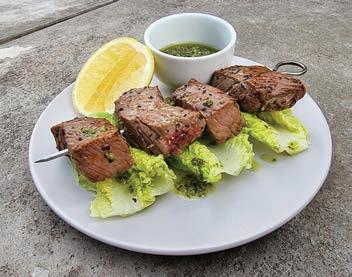
Consumers were given skewers of rump from four different breeds to judge on flavour, tenderness and overall liking. Images: Norman Hotel
Mr Correnti said the menu was annually scrutinised for its beef brands, their eating quality and availability.
“We need to partner with producers with the ability to supply the Norman Hotel with the same product day in, day out for that year. We have a great relationship with JBS and are in constant talks with them weekly.
“At the end of the day consumers are wanting quality in a steak but some prefer a grass-fed product and others grain fed.”
Herefords Australia chief executive officer Michael Crowley said the MSA Index outcomes for the breed is evidence of the eating quality performance of the breed from Queensland to Tasmania.
“Hereford producers are consistently ranked at the top end of MSA graded cattle nationally, reinforcing Hereford’s ability to deliver superior eating quality beef,” Mr Crowley said.
Herefords dominated the 2023 Ekka, with Truro Sherlock, owned by Scott and Pip Hann, winning the coveted Supreme Exhibit of the Show. Additionally, Tom Nixon of Devon Court Herefords secured a victory in the 70-day grain-fed class of the Paddock to Palate competition, clinching the daily weight gain category.
The Battle of the Breeds award capped off the paddock to plate trifecta for the breed.
The Ekka was a showcase for Hereford cattle, as they excelled in the stud cattle, commercial cattle, and beef eating quality competitions. This collectively demonstrates the breed's ability to deliver superior genetics, exceptional commercial productivity, and outstanding consumer eating quality.




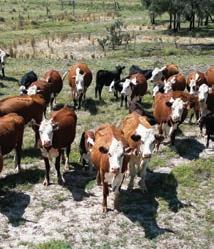
22 HEREFORDS Australia l BUILT FOR QLD, BUILT FOR CROSS BREEDING www.weetalabah.com.au 0409 741 818 (
Award-winning chef and beef tasting judge Frank Correnti.



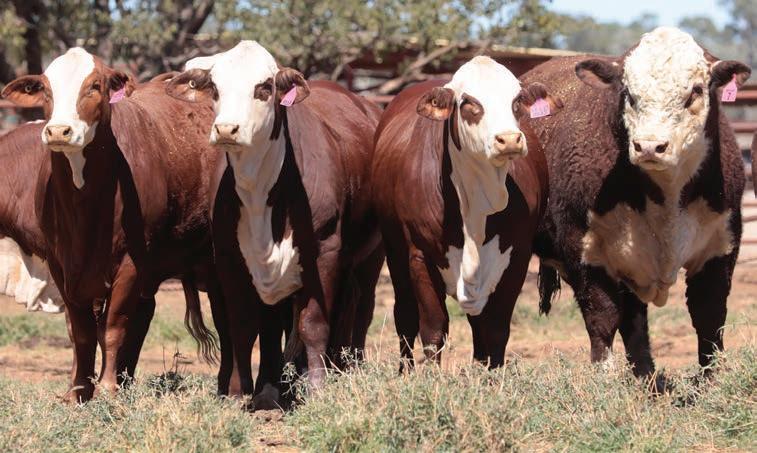
• improved temperament
MERAWAH BULLS will give you the whiteface advantage
• increased fertility
• increased weight gains
• increased market access
• and the best xbred mothers you’ll ever see!!
Hereford/Santa x steers from CA Flower & Sons, Roma QLD
Merawah bred
Mt Riddock Station, NT
Merawah Quicksilver T18 - sells July 16
cows at
ANNUAL BULL SALE 60 BULLS July 16, 1pm @ “Merawah”, BOGGABILLA MERAWAH Andrew Mackay 0428 140 175 E: amac860@gmail.com www.merawahpollherefords.com.au
Hereford x calves at Winvic Pastoral, Clermont QLD



































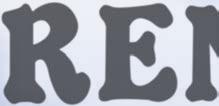














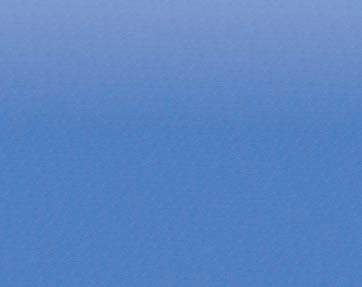
















































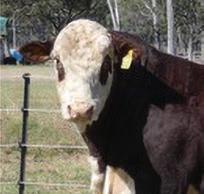







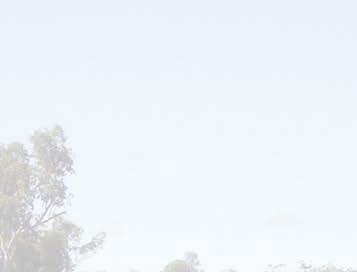







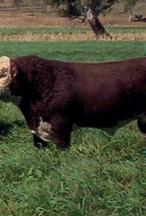
4PG | 4 PERFORMANCE | GENETICS www.remoleapollherefords.com.au MONDAY 15 JULY 202 Commencing at 1pm On On-PPro r pe pertrty y at a Remmololea e | 3004 4 O’ O Leeary y Ro R add, Cl C ifto t n Qld Vendors: HILARY O’LEARY: 07 4695 9199 or 0428 959 199 Email: admin@remoleapollherefords.com.au PAT O’LEARY: 0417 572 790 TERRY O’LEARY: 07 4697 3473 Mark Duthie 0448 016 950 Value adding ~ Northern Beef Industry @RemoleaPollHerefords Blooded Morphology Vibrovax Pestigard BEF 55 BULLS “ A l l ab out Hereford–Allabout Be e f ” BULL VIEWING DAY: Friday 4 June 4 Remolea Scone S169
“Top Price Bull, 2023” %rebate tooutside agents ➧ increase fertility ➧ boost weaning weights
improve docility
boost MSA index
increase prot
increase longevity
(PP)
➧
➧
➧
➧
Remolea-sired calves ready to wean –“Sedgley, The Gums”






 Calves are weighed at birth for solid data to enhance the accuracy of EBVs. This also enables accurate selection of bulls suitable for heifer joining.
Calves are weighed at birth for solid data to enhance the accuracy of EBVs. This also enables accurate selection of bulls suitable for heifer joining.












































































































































































